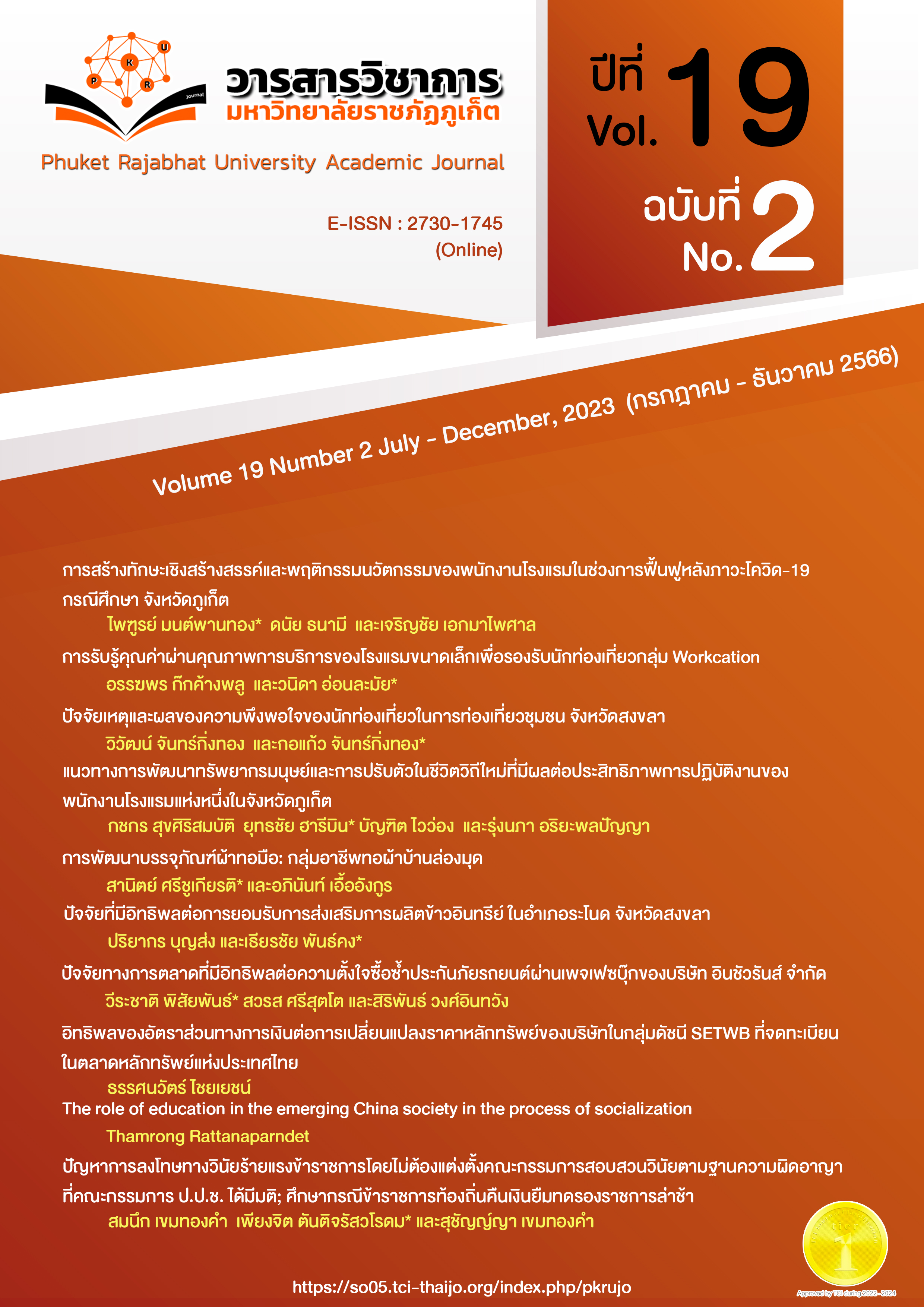ปัจจัยที่มีอิทธิพลต่อการยอมรับการส่งเสริมการผลิตข้าวอินทรีย์ ในอำเภอระโนด จังหวัดสงขลา
Main Article Content
บทคัดย่อ
การศึกษาในครั้งนี้มีวัตถุประสงค์เพื่อศึกษา (1) สภาพการผลิตข้าวทั่วไปของเกษตรกร (2) ระดับการยอมรับการส่งเสริมการผลิตข้าวอินทรีย์ของเกษตรกร และ (3) ปัจจัยที่มีอิทธิพลต่อการยอมรับการส่งเสริมการผลิตข้าวอินทรีย์ของเกษตรกร ในอำเภอระโนด จังหวัดสงขลา โดยใช้แบบสอบถามเชิงโครงสร้างเป็นเครื่องมือในการเก็บรวบข้อมูล มีกลุ่มตัวอย่างจำนวน 400 ราย ใช้วิธีการคำนวณขนาดของกลุ่มตัวอย่างของ Taro Yamane ที่ระดับความเชื่อมั่นร้อยละ 95 การเก็บข้อมูลตัวอย่างตามสัดส่วนโควตาที่กำหนดในแต่ละตำบล ใช้การสุ่มแบบบังเอิญ (Accidental Sampling) สถิติที่ใช้ในการวิเคราะห์ข้อมูล ได้แก่ ความถี่ ค่าร้อยละ ค่าเฉลี่ย และส่วนเบี่ยงเบนมาตรฐาน และการวิเคราะห์ถดถอยพหุคูณแบบขั้นตอน (Stepwise Multiple Regression Analysis) โดยใช้วิธี Stepwise มีระดับนัยสำคัญทางสถิติที่ 0.05
ผลการศึกษาพบว่า (1) การผลิตข้าวของเกษตรกรมีการทำนาปีละ 2 ครั้ง ทำนาทั้งระบบอินทรีย์และระบบเคมีมากที่สุด คิดเป็นร้อยละ 69.50 รองลงมาเป็นการทำนาในระบบเคมี คิดเป็นร้อยละ 30.30 และการทำนาในระบบอินทรีย์ ร้อยละ 0.30 ตามลำดับ ส่วนใหญ่มีประสบการณ์ในการทำนาอินทรีย์น้อยกว่า 5 ปี คิดเป็นร้อยละ 94.00 ส่วนใหญ่ปลูกข้าวพันธุ์ส่งเสริม คิดเป็นร้อยละ 99.50 ผลผลิตข้าวเฉลี่ย 652 กิโลกรัมต่อไร่ จำหน่ายผลผลิตเป็นข้าวเปลือก คิดเป็นร้อยละ 99.00 เหตุผลของการปรับเปลี่ยนจากการทำนาในระบบเคมีสู่ระบบอินทรีย์ เนื่องจากระบบเคมีทำให้ดินเสื่อมโทรมมากที่สุดคิดเป็นร้อยละ 91.50 รองลงมาคือต้องการลดต้นทุนการผลิต คิดเป็นร้อยละ 91.00 และเกษตรกรคำนึงถึงสุขภาพร่างกาย คิดเป็นร้อยละ 90.80 ตามลำดับ (2) ระดับการยอมรับการส่งเสริมการผลิตข้าวอินทรีย์ของเกษตรกรอยู่ในระดับขั้นประเมินผล คะแนนเฉลี่ย เท่ากับ 3.45 และ (3) ปัจจัยที่มีอิทธิพลต่อการยอมรับการส่งเสริมการผลิตข้าวอินทรีย์ของเกษตรกร ได้แก่ ลักษณะการทำนา ประสบการณ์การทำนาอินทรีย์ การจัดการวัตถุดิบที่นำมาใช้ทำสารอินทรีย์ ระบบเคมีทำให้ดินเสื่อมโทรม การได้รับการอบรมจากหน่วยงานอื่น ๆ ลักษณะอาชีพรอง แหล่งรับซื้อผลผลิตมีน้อย สถานภาพ ราคาข้าวขายได้ราคาต่ำกว่าที่ควรจะเป็น และการคำนึงถึงสุขภาพร่างกาย
Article Details

อนุญาตภายใต้เงื่อนไข Creative Commons Attribution-NonCommercial-NoDerivatives 4.0 International License.
เนื้อหาและข้อมูลในบทความที่ลงตีพิมพ์ในวารสารวิชาการมหาวิทยาลัยราชภัฏภูเก็ต ถือเป็นข้อคิดเห็นและความรับผิดชอบของผู้เขียนบทความโดยตรง ซึ่งกองบรรณาธิการวารสารฯ ไม่จำเป็นต้องเห็นด้วยหรือร่วมรับผิดชอบใด ๆ
บทความ ข้อมูล เนื้อหา รูปภาพ ฯลฯ ที่ได้รับการตีพิมพ์ในวารสารวิชาการมหาวิทยาลัยราชภัฏภูเก็ต ถือเป็นลิขสิทธิ์ของวารสารวิชาการมหาวิทยาลัยราชภัฏภูเก็ต หากบุคคลหรือหน่วยงานใดต้องการนำทั้งหมดหรือส่วนหนึ่งส่วนใดไปเผยแพร่ต่อหรือเพื่อกระทำการใด ๆ จะต้องได้รับอนุญาตเป็นลายลักษณ์อักษรจากวารสารวิชาการมหาวิทยาลัยราชภัฏภูเก็ตก่อนเท่านั้น
เอกสารอ้างอิง
Bunsong, P. (2014). An analysis of price variation and supply response of major rice in Thailand. [Master’s thesis]. Prince of Songkhla University.
Chaisaeng, V. (2021). Farmers Adoption of Organic Farming: An Application of the Theory of Planned Behavior and Expectancy Value. Journal of Economics and Management Strategy. 8(2), 122-142.
Chaiubon, A., Wiseansat, A. & Pensuk, V. (2020). Factors influencing on decision making of organic, good agricultural practice or chemical rice cultivation for farmers in Ban Kong-So-Dao Subdistrict, Nunsung District, Udon Thani province. Udon Thani Rajabhat University Journal of Sciences and Technology. 8(2), 201-215.
Integrated Provincial Administration Committee (2019). Songkhla Provincial Development Plan 2018-2022, Review Edition 2021. https://www.songkhla.go.th/files/com_ news_develop_plan/2020-07_1a959e630a5165d.pdf
Khaowiset, T. (2020). Adoption of Organic Agriculture of Rice Farmers in SamChuk District, SuphanBuri Province. Postgraduate Symposium, (pp.943-954). Rangsit University,
Lakmuang, K., Ratanachai, A. & Phapatigul, P. (2016). Factors Related to Attitude on Sufficiency Economy Philosophy of Rice Farmers in Songkhla Province. Khon Kaen Agriculture Journal, 44(1), 75-82.
Lekklang, S., Monkeb, P. & Limanggul, T. (2011). Factors affecting the decision making on organic rice production of farmers in Surin Province. Proceedings of 49th Kasetsart University Annual Conference: Agricultural Extension and Home Economics, (pp. 131-136). Kasetsart University.
Marnmad, K. (2016). Rice Production and Consumption of the Farmers in Ranot District, Songkhla Province. [Minor Thesis Degree of Master]. Prince of Songkla University.
Mosher, A T. (1978). An Introduction to Agricultural Extension. Singapore National Printer (Pte) Ltd.
National Statistical Office of Thailand. (2020). Thailand Population Statistic 2020. Retrieved January 10th, 2021, from http://www.nso.go.th/sites/2014/Pages/home.aspx
Office of Agricultural Economics. (2023). Thailand Agricultural Statistic 2022. Office of Agricultural Economics, Ministry of Agriculture and Cooperatives.
Phanpinit, S. (2001). Agricultural Extension. Aksornpittaya press.
Phitthayaphinant, P. & Tongkaemkaew, U. (2018). From Chemical Paddy Fields to Organic Paddy Fields on a Self-Sufficient Path: Lessons Learned form the Traditional Growing Area for Sangyod Rice in Phattalung province. Journal of Community Development Research (Humanities and Social Sciences). 11(4), 64-67.
Sangwan, C & Priyasuthinan, U. (2014). Rice fields in Ranod: The rice farmers’ changing way of life amidst globalization. Journal of Language, Religion and Culture, 3(1). 109–124.
Wajasuwan, T. & Wongsansukcharoen, J. (2022). Acceptance of Technology and Innovation Affecting the Intention of Using Drone for Agriculture in the Agricultural Industry. Panyapiwat Journal. 14(1), 143–157.
Yathip, N. (2017). Acceptance behavior and attitudes towards using the ready-made program for machine management: A case study of a factory for manufacturing electronic appliances in the Sahaphat Group Industrial Park, Si Racha. [Master’s thesis] Kasetsart University.
Yoosuk, A. (2012). The Paradigm of technology transfer in agricultural a new theory. Journal of Vocational and Technical Education. 2(4), 14-24.
Yotongyos, M. & Sawaddesan, P. (2008). Identifying Sample size for Research. Retrieved September 16th, 2021, from http://research.bu.ac.th/knowledge/kn46/Samplesize.pdf


